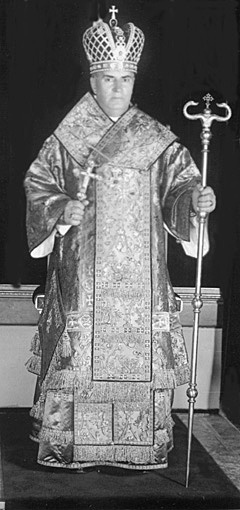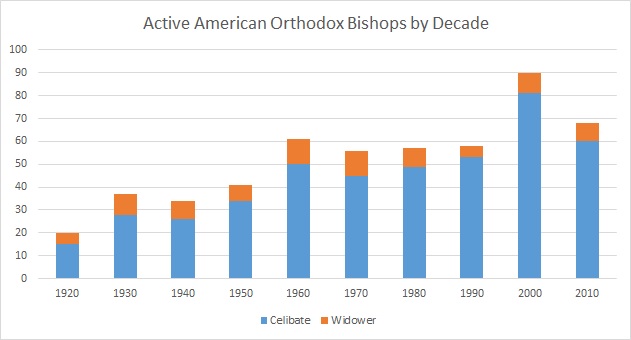
I have a list of 213 Orthodox bishops who have served in America. Of these, 179 were never married (we’ll call them “celibates”), and the other 34 were widowers. So 84% celibates, 16% widowers. (Two of the “widowers” are special cases, because they were widowed before they joined the clergy, so they never served as married priests. But I classified them as widowers for this study.) Here are a few observations from the data:
Most of the bishops were ordained priests in their twenties.
Median age at priestly ordination:
- Celibates: 29
- Widowers: 24
This is pretty remarkable, because canonically, the minimum age for priestly ordination is 30. Yet I found that 58% of American Orthodox bishops were ordained to the priesthood before the age of 30. I realize that there are exceptional cases — just in this study, Saints Innocent of Alaska, Tikhon of Moscow, and Raphael of Brooklyn were all in the under-30 group and went on to become canonized saints. But the face that under-30 ordination is the norm rather than the exception, is remarkable, and perhaps somewhat concerning.
Widower bishops are much older than celibates.
Median age at hierarchical consecration:
- Celibates: 44
- Widowers: 58
This is less surprising: widower bishops tend to be quite a bit older than their celibate counterparts. Even so, it’s rather striking to see that just one celibate bishop was consecrated at age 70 or older (Germanos Liamadis, age 71), while six of the 34 widowers were at least 70 (so, 18%).
Roughly one-in-ten American Orthodox bishops has had a bad end to his career.
I tried to identify every bishop who had what you might call a bad end to his career… Mostly, we’re talking about bishops who were defrocked or forcibly retired due to some sort of misconduct. I also included cases of apostasy or major scandal. I found three of these among the widowers (9%) and 20 among the celibates (11%). It’s possible that, with further research, those numbers will go up a little bit (especially for the celibates, where I was lacking information on a decent number of them). But at this stage, we can estimate that roughly one out of every ten bishops in American Orthodox history has seen his career end badly. And the numbers for widowers aren’t dramatically better than for celibates.
The heyday for widower bishops was the 1960s and ’70s.
The 1960s and 1970s both had eleven active widower bishops, the most of any decade. The low point (since 1920) was the 1990s, when only five active bishops were widowers. Our current decade has seen eight widower bishops, of whom six are active (among the other two, one died and one was forced to retire).
Just because I have the data, and it’s sort of interesting — active bishops by decade (and please note — I know I’m missing some bishops, so these numbers aren’t exact):

It’s rather striking to the see the 2000s so far above all the other decades, in terms of total active bishops (driven by the huge number of celibates). I thought maybe this had to do with the many longtime bishops who retired or died in the 2000s — 22 bishops had their last active year in America in the 2000s, compared to 14 in the 1990s. But then our current decade, which has only half a year left to go, has seen 20 bishops die/retire/leave, and we’re nowhere near the number of total bishops in the 2000s.
One Reply to “Statistics on Celibate & Widower Bishops in American Orthodoxy”